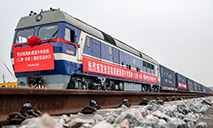High volatility seen in commodity prices amid Ukraine crisis
LONDON, March 8 (Xinhua) -- Price fluctuations of commodities have jumped to a high level with the Russia-Ukraine conflict evolving and the possibility of Russian oil embargo looming. Prices of energy, metals and grains seesawed, underpinning the outlook for higher inflation.
Even if the conflict itself does not spread further, "its economic effects almost definitely will, mainly transmitted through higher commodity prices, with the focus on natural gas, oil and grains," said John Wyn-Evans, head of investment strategy from the investment management company Investec Wealth &Investment.
Benchmark Dutch TTF natural gas futures briefly touched a record high of 345 euros (375 U.S. dollars) per megawatt hour on Monday. Official statistics showed Russia accounts for about 40 percent of imports of natural gas to the European Union. Western sanctions against Russia have largely bypassed energy, but traders remained concerned about possible supply disruptions.
"Europe still has enough supplies to meet the heating demand this spring," Fu Xiao, head of commodity markets strategy at Bank of China International, told Xinhua. "However, restocking over the summer for the next heating season can be very challenging."
Oil prices witnessed a big daily swing on Monday, with Brent crude, a global benchmark, surging to over 139 dollars in early trade over the fear of possible oil embargo, hitting a near 14-year high. It was 147.50 dollars in July 2008. The surge battered European stock markets, "as shocks to the oil market often pave the way for recessions," said the fintech firm Equiti.
The ongoing market volatility has pushed up the global gold price to over 2,000 dollars per ounce. As investors are worrying about the geopolitical and economic consequences of the Russia-Ukraine conflict, the demand for the safe haven asset continued to increase.
Following the strong performance, the price would target the early August 2020 high at 2,075 dollars, said Chris Beauchamp, analyst from British trading provider IG.
"The situation remains highly uncertain though and markets extremely volatile which should ensure gold remains a firm favourite," said Craig Erlam, an analyst of online forex trading and broker OANDA. "All-time highs are not that far away and in the current environment, there's every chance that we see it surpassed at some point."
According to OANDA analyst Ed Moya, "too much uncertainty with commodity prices and economic growth prospects should keep gold prices supported" until investors become optimistic that a negotiated end of the military conflict is in sight.
As for some other metals, the price of nickel, largely used in stainless steel, skyrocketed by more than 110 percent on the London Metal Exchange on Tuesday to record 100,000 dollars a tonne, the biggest price changes ever seen. The price of palladium, mainly used in catalytic converters, also jumped to a new record high. Russia was a major producer of the metals.
Concerns over grain production and export were fueled as well. Russia and Ukraine were big food suppliers, especially in grains. Together they accounted for 25 to 30 percent of global wheat exports, and around 80 percent of global sunflower seeds, according to the London-based consultancy Capital Economics.
"The ongoing uncertainty suggests that grains and oilseed markets will continue to price in a significant risk premium," said Warren Patterson, head of commodities strategy with the ING Group, a Dutch financial services corporation.
"Lost export supply from Ukraine and Russia would tighten up global wheat and corn balances significantly, and as a result change the outlook for at least the next season," Patterson added.
The fallout of soaring commodity prices could quickly ripple, pushing up prices in people's daily life and stoking higher inflation. "Central bankers will find their skills put to an even greater test now, especially if inflation pressures are exacerbated by higher commodity prices as a result of shortages," said Wyn-Evans.
"This comes at a time when growth, though strong by pre-pandemic standards, is declining, and when company margins and profits are under threat from rising input costs," he added.
Photos
Related Stories
- Zelensky says ready for dialogue with Russia on security guarantees, Donetsk, Lugansk
- WHO official calls for health, humanitarian principles in resolving Ukraine crisis
- UN relief chief outlines immediate humanitarian priorities for Ukraine
- People from Ukraine arrive at railway station in Bucharest
- No breakthrough in third round of Russia-Ukraine talks
Copyright © 2022 People's Daily Online. All Rights Reserved.










